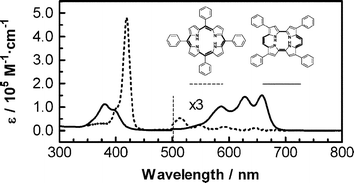The photophysical properties of 2,7,12,17-tetraphenylporphycene (TPPo) and its palladium(II)
(PdTPPo) and copper(II)
(CuTPPo) complexes as well as comparisons with those of their porphyrin counterparts are reported. All porphycenes absorb in the red part of the spectrum, but only TPPo shows fluorescence (ΦF
= 0.15). This compound presents good quantum yields of triplet (ΦT
= 0.33) and singlet oxygen (ΦΔ
= 0.23) formation. In the case of PdTPPo, fluorescence is inhibited by the internal heavy-atom effect and the triplet and singlet oxygen quantum yields are enhanced (ΦT
=
ΦΔ
= 0.78). The presence of the paramagnetic ion Cu(II) in CuTPPo further enhances the non-radiative transitions leading to an internal conversion quantum yield Φic
= 0.65 and to a triplet quantum yield ΦT
= 0.35. With a triplet lifetime of 700 ns, CuTPPo is nevertheless able to sensitise singlet oxygen with a quantum yield that strongly depends on the oxygen concentration in the environment. These photophysical properties, together with their ability to kill several cancer cell lines, place these sensitisers in a good position to be used in photodynamic therapy (PDT).

You have access to this article
 Please wait while we load your content...
Something went wrong. Try again?
Please wait while we load your content...
Something went wrong. Try again?


 Please wait while we load your content...
Please wait while we load your content...